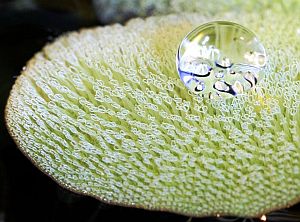An inconspicuous plant could soon embark on a career as a climate saver: hairs on the surface of water ferns are to allow ships to have a 10 per cent decrease in fuel consumption. The plant has the rare ability to put on a gauzy skirt of air under water and keep this dress on for months. Researchers at the University of Bonn, Rostock and Karlsruhe have now discovered how the fern does this. Their results can possibly be used for the construction of new kinds of hulls which glide through the water in an envelope of air. Such kinds of ships would get by with significantly less fuel due to decreased friction. The scientists will present their research in the current issue of the journal 'Advanced Materials'.
The water fern salvinia molesta is exremely hydrophobic. If it is submerged and subsequently pulled out the liquid immediately drips off it. After that it is completely dry again. Or to be more precise: it was never really wet. For the fern surrounds itself by a flimsy skirt of air. This layer prevents the plant from coming into contact with liquid. And that even with a dive lasting weeks.
Materials researchers call this behaviour 'superhydrophobic'. This property is of interest for many applications such as rapidly drying swimsuits or simply for fuel-efficient ships. Meanwhile, it is possible to construct superhydrophobic surfaces modelled on nature. However, these 'replicas' have a disadvantage: the layer that forms on them is too unstable. In moving water it disappears after several hours at the latest.
The researchers from Bonn, Rostock und Karlsruhe have now deciphered the trick the water fern uses to pin down its airy skirt. It has been known for some years now that on the surface of its leaves there are tiny whisk-like hairs. These are hydrophobic. They keep water in the surroundings at a distance.
Water is 'stapled in place'
But this is only one side of the coin: 'We were able to show that the outermost tips of these whisks are hydrophilic, i.e. they love water,' Professor Wilhelm Barthlott from the University of Bonn explains. 'They plunge into the surrounding liquid and basically staple the water to the plant at regular intervals. The air layer situated beneath it can therefore not escape so easily.'
Professor Barthlott is head of the Nees Institute of Biodiversity of Plants in Bonn. There the experiments began which are continued today in conjunction with the Chair of Fluid Dynamics at the University of Rostock and the Institute of Applied Physics at the University of Karlsruhe. 'After the solving of the self-cleansing of the lotus leaf twenty years ago, the discovery of the salvinia effect is one of the most important new discoveries in bionics,' Professor Thomas Schimmel from the University of Karlsruhe says.
Fuel saved world wide: one per cent
And it is one with huge technical potential to boot. Up to now with container ships more than half of the propulsion energy is lost through friction of the water at the hull. With an air layer this loss could be reduced by ten per cent according to the researchers' estimate. Since ships are huge fuel guzzlers, the total effect would be enormous. 'Probably one per cent of the fuel consumption worldwide could be saved this way, is Professor Barthlott's prognosis. 'Surfaces modelled on the water fern could revolutionise shipbuilding,' Dr. Martin Brede from the University of Rostock concurs.
Lotus and the water fern salvinia are only two of maybe twenty million species populating our planet. They all have their secrets, and Bonn, Rostock and Karlsruhe are working on unlocking these.
In close partnership with society, KIT develops solutions for urgent challenges – from climate change, energy transition and sustainable use of natural resources to artificial intelligence, sovereignty and an aging population. As The University in the Helmholtz Association, KIT unites scientific excellence from insight to application-driven research under one roof – and is thus in a unique position to drive this transformation. As a University of Excellence, KIT offers its more than 10,000 employees and 22,800 students outstanding opportunities to shape a sustainable and resilient future. KIT – Science for Impact.

